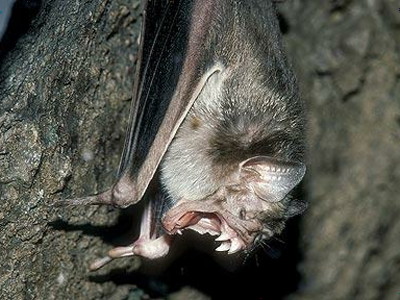It turns out that not only humans but also vampire bats 'keep a social distance when they get sick'

by
In order to curb the spread of the new coronavirus infection (COVID-19), policies have been promoted in each country to 'keep social distance'. Studies have shown that not only humans keep a social distance when they get sick, but also bats, which are known to carry various viruses, keep a social distance when they get sick.
Tracking sickness effects on social encounters via continuous proximity sensing in wild vampire bats | Behavioral Ecology | Oxford Academic
https://academic.oup.com/beheco/advance-article/doi/10.1093/beheco/araa111/5937165
Even vampire bats social distance when they get sick
https://www.zmescience.com/ecology/animals-ecology/vampire-bats-social-distance-05252/
Even Vampire Bats Socially Distance Themselves When They Feel Sick
https://www.sciencealert.com/vampire-bats-social-distance-when-they-feel-sick
Bats are known to carry various viruses, and the new coronavirus (SARS-CoV-2) is also thought to be a bat-derived virus. Bats have a special mechanism of protein activity involved in immune and inflammatory reactions, so it is said that bats carry viruses that are dangerous to humans but do not develop themselves.
What is the mechanism by which bats carry a large number of viruses without getting sick? --GIGAZINE

A research team led by Associate Professor Gerald Carter , a behavioral ecologist at The Ohio State University, found in a previous study that lipopolysaccharide-infected vampire bats had abnormal immune responses and were sometimes fatal. I did. Bats that became ill due to lipopolysaccharide have less movement, and social interactions such as grooming have also decreased.
However, the study was conducted in the laboratory, and it was unclear how bats that became ill in the wild would react. Therefore, Carter collaborated with Simon Ripperger , a postdoctoral researcher at the Smithsonian Tropical Research Institute , to conduct an experiment on vampire bats in Belize , Central America.
Research over the past few years has revealed that there is a colony of vampire bats in a hollow tree, so the research team set up a net at sunset to capture the vampire bats. The research team, which captured a total of 31 vampire bats, injected 16 of them with lipopolysaccharide and the remaining 15 with saline. The vampire bat, which was injected with lipopolysaccharide, did not die, but he said he was ill for several hours.
In addition, the research team attached sensors lighter than a dime to all vampire bats, released them, and tracked their movements for the next three days. The sensor outputs a signal every 2 seconds to supplement another sensor within 5m to 10m. From the strength of the signal transmitted from the nearby sensor and the time to supplement it, it is possible to track how close the vampire bats with the sensor are.

by Simon Ripperger
Follow-up showed that within the first 6 hours of installing and releasing the sensor, a healthy vampire bat injected with saline had a 49% chance of contacting another individual. On the other hand, the vampire bat, which was injected with lipopolysaccharide and became ill, had a 35% chance of coming into contact with other individuals. The research team reports that the time spent on unwell vampire bats socially interacting with other individuals decreased by an average of 25 minutes.
The vampire bats inoculated with lipopolysaccharide eventually recovered, and 48 hours after the start of follow-up, the social interaction of the sick vampire bats was similar to that of other healthy individuals. It seems that he has recovered.
The results of this follow-up suggest that the research team-induced illness has dramatically changed the social network of vampire bats. 'I was surprised that the effect was clearly visible,' Ripperger said. 'I was able to see what was happening just by looking at social networks without complicated statistical analysis.' I have commented.
by
Keeping a social distance from other individuals in the event of illness may help avoid spreading the pathogen infection to other individuals and endangering the colony. On the other hand, Ripperger points out that the changes in social interaction seen in the vampire bat colony are unlikely to have been voluntarily caused by the sick vampire bat.
The research team believes that poorly ill vampire bats are lethargic and sleep more than healthy individuals, thus reducing their social interaction with other individuals. “Imagine you have the flu and you're exhausted and unwilling to get out of bed. As a result, you'll meet fewer people in your daily life,” Ripperger said.
The results of this study are based on artificially caused illness, and it is unclear whether vampire bats will respond in a similar manner when exposed to actual pathogens. 'It's important to remember that behavioral changes also depend on pathogens,' said Carter. 'Some illnesses may increase the likelihood of interaction rather than reduce it.' did.

by Josh More
It is known that not only vampire bats but also some lobsters and insects detect diseased individuals and reduce social interaction.
Related Posts:







